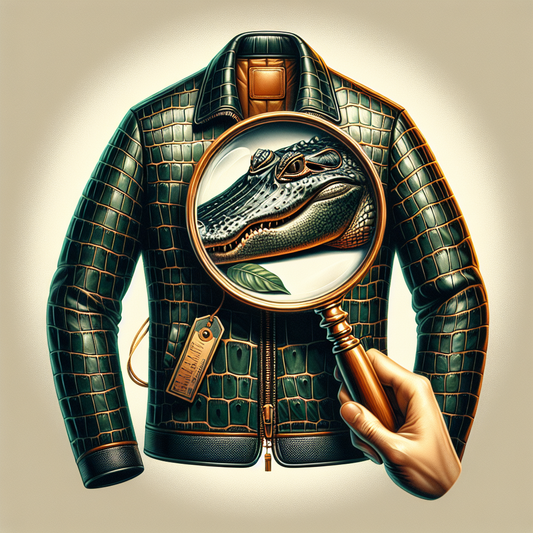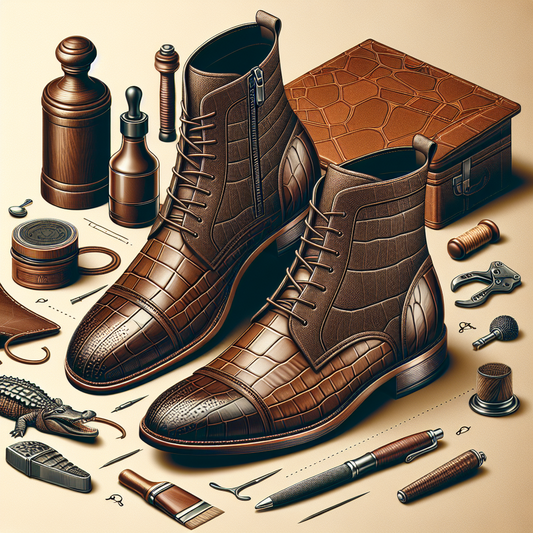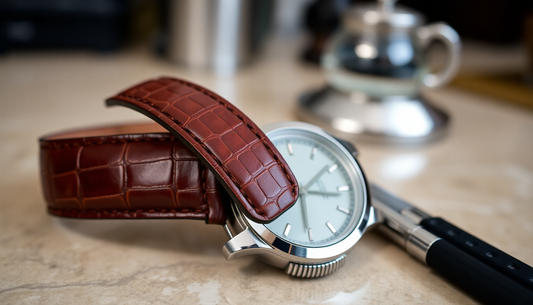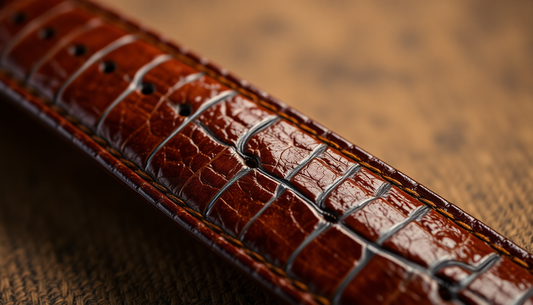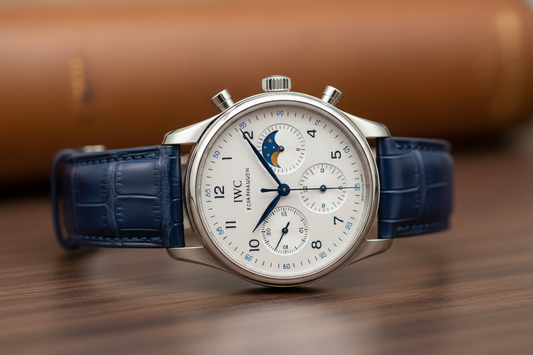Differences between crocodile and alligator straps
In the world of luxury accessories, the details matter.
One such detail is the choice of material, particularly when it comes to leather straps.
Two of the most sought-after types are crocodile and alligator straps. Both are considered symbols of elegance and sophistication.
However, distinguishing between these two can be a challenge. They share many similarities, but also have unique characteristics that set them apart.
In this guide, we delve into the differences between crocodile and alligator straps. We'll explore their appearance, texture, durability, and much more.
Whether you're a fashion enthusiast, a watch collector, or simply curious, this article will help you make an informed decision when choosing between these two types of leather straps.
"
Understanding Crocodile and Alligator Leather
Crocodile and alligator leathers are both derived from reptiles belonging to the Crocodylia order.
However, they come from different species. Crocodile leather can come from various crocodile species, while alligator leather is specifically from the American Alligator or the Chinese Alligator.
These leathers are highly valued in the fashion industry for their unique texture and durability. They are commonly used in high-end accessories, particularly watch straps.
The quality of the leather can be influenced by several factors. These include the age of the animal, the environment in which it was raised, and the tanning and finishing processes used.
Here are some key features to look for in crocodile and alligator leathers:
- Visible pore patterns in crocodile leather
- Smoother texture with less visible pores in alligator leather
- Unique umbilical scar in genuine alligator skin
- Variation in scale patterns and shapes
Key Differences in Appearance
When comparing crocodile and alligator straps, one of the most noticeable differences is in their appearance.
Crocodile leather is known for its distinct pattern of pores, which are hair follicle scars. These pores are visible as small dots arranged in a row on each scale.
On the other hand, alligator leather has a smoother texture. The pores are less visible, giving it a more uniform look. A unique feature of alligator skin is the presence of an umbilical scar, which is a web-like pattern that is not found in crocodile skin.
Here are some key differences in appearance to note:
- Crocodile leather has visible pore patterns
- Alligator leather has a smoother texture with less visible pores
- The umbilical scar is a unique feature of genuine alligator skin
Texture and Durability: What to Expect
The texture of crocodile and alligator straps can greatly influence their comfort and flexibility. Crocodile leather, with its visible pores and irregular scales, tends to have a more rugged texture. This can add a unique tactile experience to the strap.
Alligator leather, on the other hand, is known for its smoother texture. The scales are more consistent and rectangular, contributing to a more uniform feel. This can make alligator straps slightly more comfortable for some wearers.
Both types of straps are highly durable, capable of withstanding years of use. However, their longevity greatly depends on proper maintenance and care. Regardless of the type, a well-cared-for strap can develop a beautiful patina over time, adding to its character and appeal.
The Rarity Factor: Alligator vs. Crocodile
Alligator straps are often considered more prestigious due to their rarity. Genuine alligator skin, especially from the American alligator, is less common in the market. This scarcity adds to its allure and perceived value.
Crocodile straps, while still considered a luxury item, are more widely available. Different species of crocodiles are farmed globally for their skin, making crocodile leather more accessible. This can make crocodile straps a more affordable option for those seeking exotic leather.
However, the rarity or abundance of the leather does not necessarily reflect its quality. Both alligator and crocodile straps can offer exceptional durability and aesthetic appeal.
Legal and Ethical Considerations
When purchasing crocodile or alligator straps, it's crucial to consider the legal and ethical implications. Both crocodiles and alligators are protected species in many regions, and their trade is regulated by international laws.
The Convention on International Trade in Endangered Species (CITES) certification is a key indicator of legal sourcing. This certification ensures that the leather is sourced legally and sustainably, without threatening the species' survival.
Ethical considerations also extend to the conditions in which the animals are raised and the impact of leather production on local ecosystems.
Price Point and Value
The price of crocodile and alligator straps can vary greatly. Factors such as the size of the strap, the quality of the leather, and the brand all contribute to the final cost.
Generally, alligator straps are considered more prestigious and are often priced higher due to their rarity. However, both types of straps are seen as luxury items and can command high prices.
Investing in a high-quality strap can add significant value to a timepiece, enhancing its aesthetic appeal and potentially increasing its resale value.
Maintenance and Care for Longevity
Both crocodile and alligator straps require regular maintenance to ensure their longevity. This involves cleaning and conditioning the leather to prevent it from drying out and cracking.
Proper care can significantly extend the life of the strap, preserving its texture and appearance. It's also important to store the strap in a suitable environment to prevent damage from humidity or extreme temperatures.
Here are some basic care tips:
- Clean the strap with a soft, dry cloth to remove dirt and oils.
- Apply a leather conditioner to keep the strap supple and prevent drying.
- Avoid exposure to water and direct sunlight.
- Store the strap in a cool, dry place when not in use.
"by Jeremy Beadle (https://unsplash.com/@jeremybeadle)"
Identifying Authenticity: Avoiding Imitations
In the world of luxury goods, imitation products are a common issue. This is especially true for crocodile and alligator straps, where the high price tag can make them a target for counterfeiters.
Genuine crocodile and alligator leather have unique characteristics that are difficult to replicate. These include the pattern of the scales, the texture of the skin, and the presence of an umbilical scar in alligator leather.
Buying from reputable dealers is crucial to ensure the authenticity of the strap. Always ask for certification of the leather's origin and legality.
Conclusion: Making an Informed Choice
Choosing between crocodile and alligator straps is a matter of personal preference. Both offer unique characteristics and a touch of luxury to any accessory.
Informed decisions come from understanding the differences, knowing how to identify genuine leather, and considering ethical sourcing. This knowledge ensures a purchase that aligns with your style, values, and budget.



